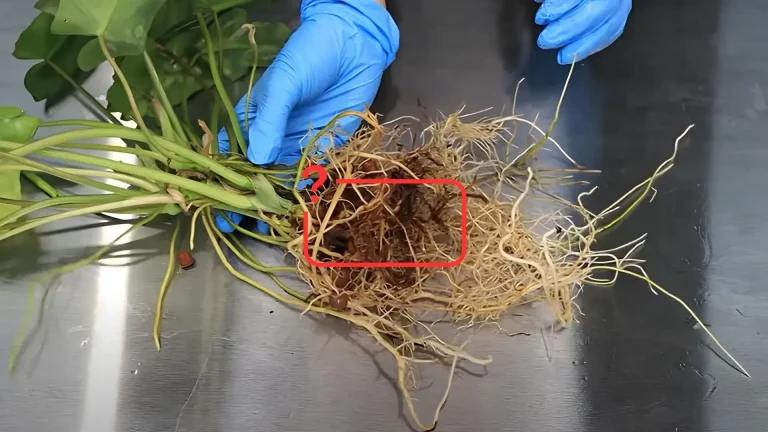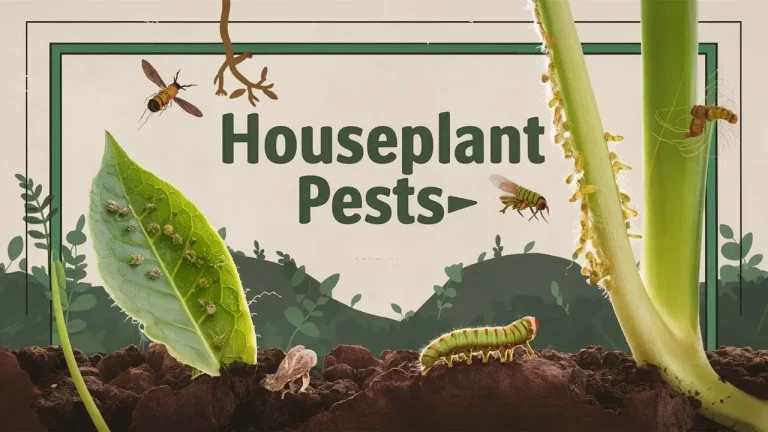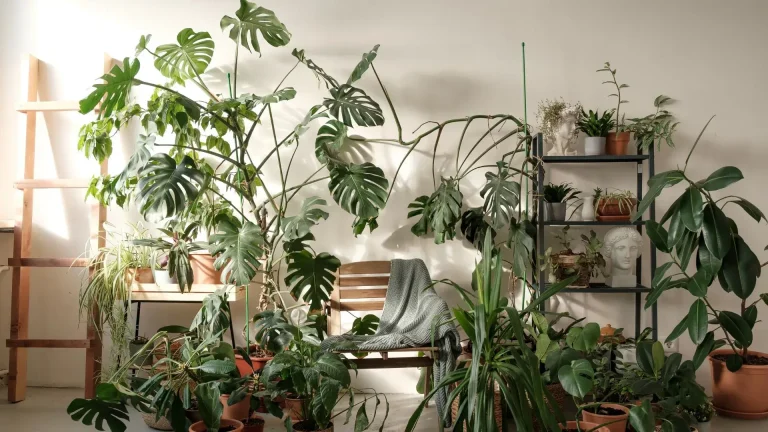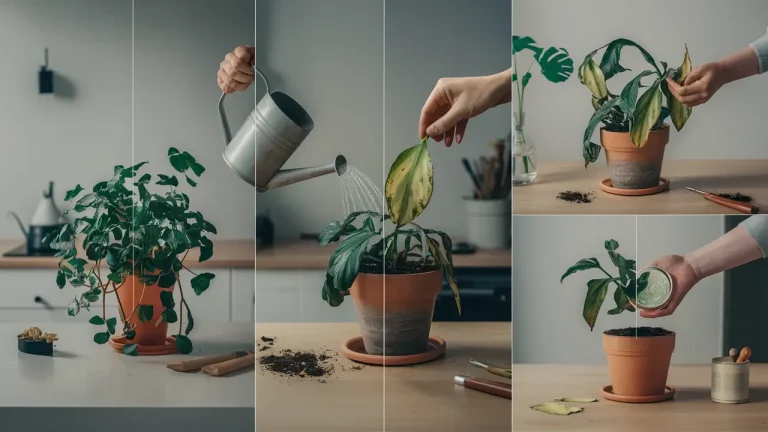Yellowing Leaves on Houseplants: Here’s What Your plant Is Trying to Tell You
Yellowing leaves on houseplants can be one of the most concerning issues for plant parents. It’s disheartening to see your lush greenery lose its vibrancy, but don’t panic—yellow leaves are a common problem with many possible causes.
More often than not, yellowing leaves are your plant’s way of signaling that something in its environment or care routine isn’t quite right. Whether it’s watering, lighting, or another factor, understanding the cause is the first step to fixing the issue.
In this guide, we’ll explore all the possible reasons for yellowing leaves and provide actionable solutions to help restore your plant’s health.
Table of Contents
Common Causes of Yellowing Leaves & Solutions
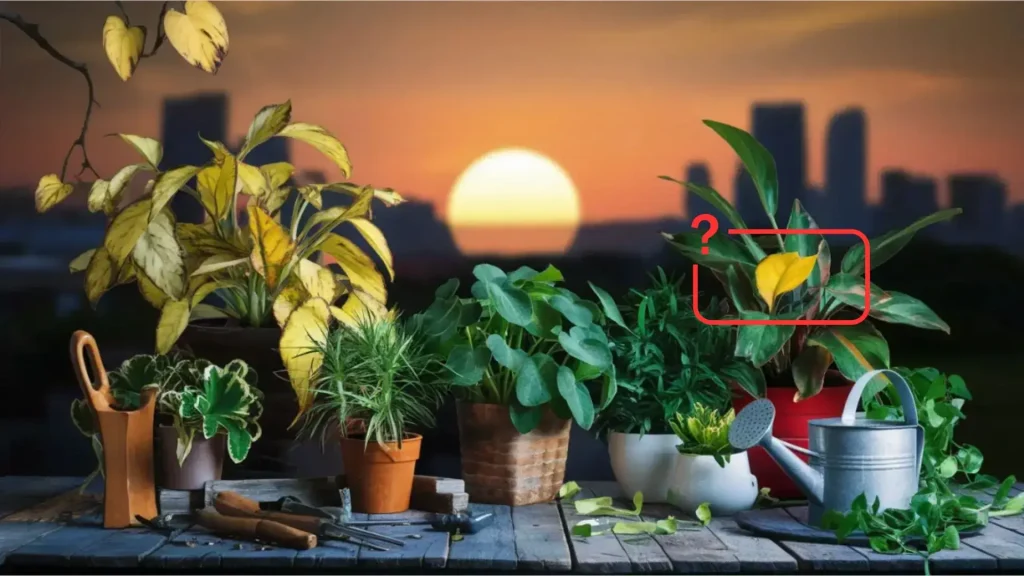
1. Watering Issues
Watering problems are among the most frequent causes of yellowing leaves. Both overwatering and underwatering can stress your plant, leading to discoloration and other symptoms.
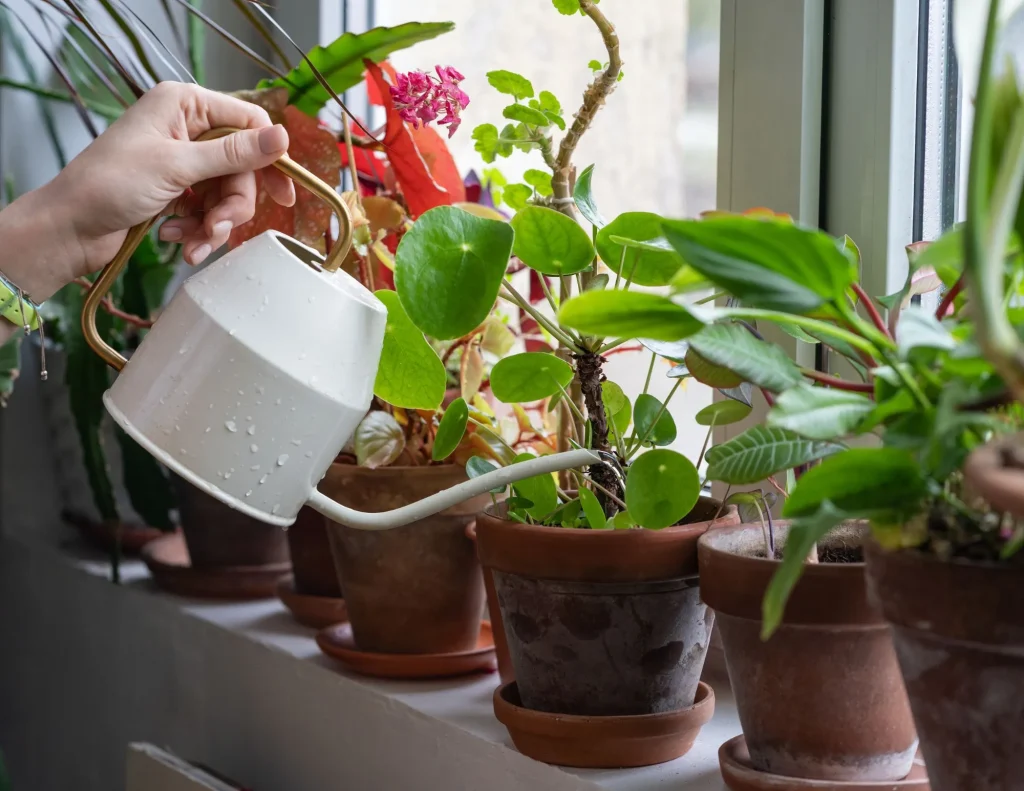
Overwatering
- What Happens: When soil becomes waterlogged, it suffocates the roots, preventing them from absorbing oxygen and nutrients.
- Signs:
- Yellowing lower leaves.
- Mushy stems.
- A foul odor coming from the soil.
- Solution:
- Check the soil moisture by inserting your finger 1-2 inches deep. If it feels soggy, hold off on watering.
- Ensure your pot has proper drainage holes and empty the saucer after watering.
- If root rot is present, repot the plant in fresh, well-draining soil and trim away any rotten roots.
Underwatering
- What Happens: Dry soil deprives the roots of moisture, causing the plant to become dehydrated.
- Signs:
- Dry, brittle leaves that may curl or fall off.
- Lightweight pots when lifted.
- Solution:
- Water thoroughly, ensuring the soil is evenly moist but not soggy. Allow excess water to drain away.
- Establish a consistent watering schedule based on your plant’s needs, adjusting for seasonal changes.
Organize your plant care effortlessly with our Printable Planner!!
2. Lighting Problems
Proper lighting is essential for photosynthesis, and inadequate or excessive light can lead to yellowing leaves.
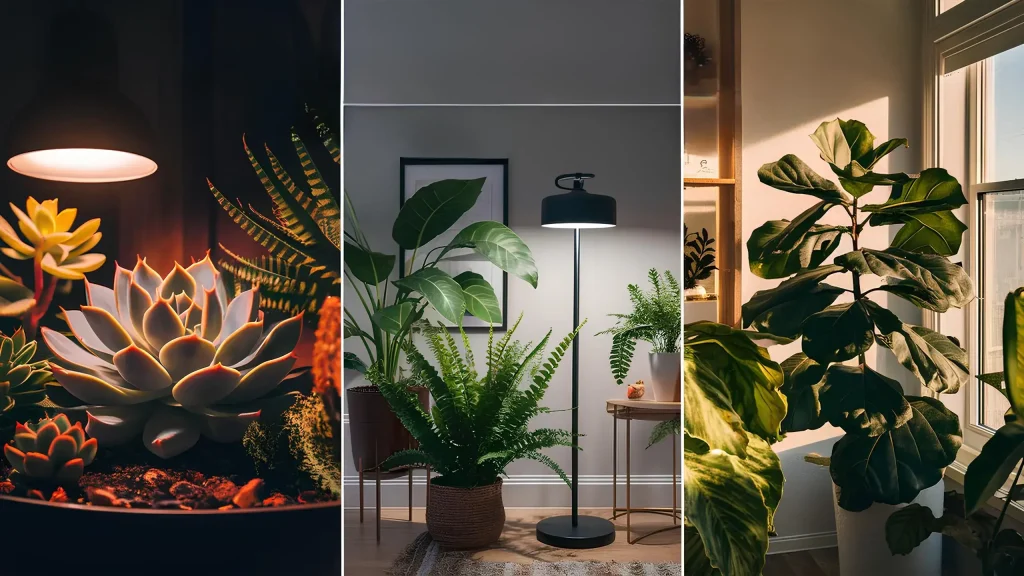
Too Much Light
- What Happens: Intense direct sunlight can scorch leaves, leading to yellowing and brown, crispy edges.
- Signs:
- Yellow leaves with brown, crispy edges or spots.
- Leaves may feel dry to the touch.
- Solution:
- Move the plant to a location with bright, indirect light.
- Use sheer curtains to diffuse intense sunlight and protect sensitive plants.
Too Little Light
- What Happens: In low-light conditions, plants can’t photosynthesize effectively, resulting in pale, yellow leaves and weak growth.
- Signs:
- Pale, yellow leaves that may feel soft or limp.
- Leggy stems as the plant stretches toward the light source.
- Solution:
- Move the plant closer to a natural light source, such as a bright window.
- Consider using grow lights to supplement light in darker spaces or during winter months.
3. Nutrient Deficiencies
Plants require a balance of nutrients to stay healthy. A lack of essential nutrients can result in yellowing leaves, often with distinct patterns that indicate which nutrient is missing.
Nitrogen Deficiency
- What Happens: Nitrogen is crucial for green, leafy growth. A deficiency often causes older leaves to turn yellow first.
- Signs:
- Pale yellow leaves starting from the bottom of the plant.
- Stunted growth.
- Solution:
- Use a balanced fertilizer or one with a higher nitrogen content.
- Follow the product’s instructions to avoid over-fertilizing.
Magnesium Deficiency
- What Happens: Magnesium is vital for photosynthesis. Its absence leads to yellowing between leaf veins, often giving the leaves a mottled appearance.
- Signs:
- Yellowing between green veins, particularly on older leaves.
- Solution:
- Apply a magnesium-rich fertilizer or use a homemade remedy like Epsom salt (1 teaspoon per gallon of water).
Iron Deficiency
- What Happens: Iron deficiency primarily affects new growth, causing young leaves to yellow while their veins remain green.
- Signs:
- Yellowing of new leaves with green veins.
- Solution:
- Use an iron supplement or chelated iron fertilizer to address the deficiency.
- Check soil pH and adjust if necessary; iron absorption decreases in highly alkaline soil.
4. Temperature Stress
Temperature extremes can cause stress that manifests as yellowing leaves.
Cold Drafts
- What Happens: Sudden exposure to cold air shocks the plant, leading to discolored or dropping leaves.
- Signs:
- Yellowing leaves near drafty windows or doors.
- Sudden leaf drop.
- Solution:
- Move plants away from drafty areas, such as near windows or air conditioning vents.
- Maintain a consistent temperature suited to your plant’s needs.
Excessive Heat
- What Happens: High temperatures dehydrate plants and cause leaf stress.
- Signs:
- Yellowing leaves with dried, crispy edges.
- Wilting, even after watering.
- Solution:
- Relocate plants to a cooler spot away from direct sunlight or heat sources like radiators.
- Mist plants or increase humidity to help them recover.
5. Humidity Problems
Humidity plays a critical role in plant health, especially for tropical species.
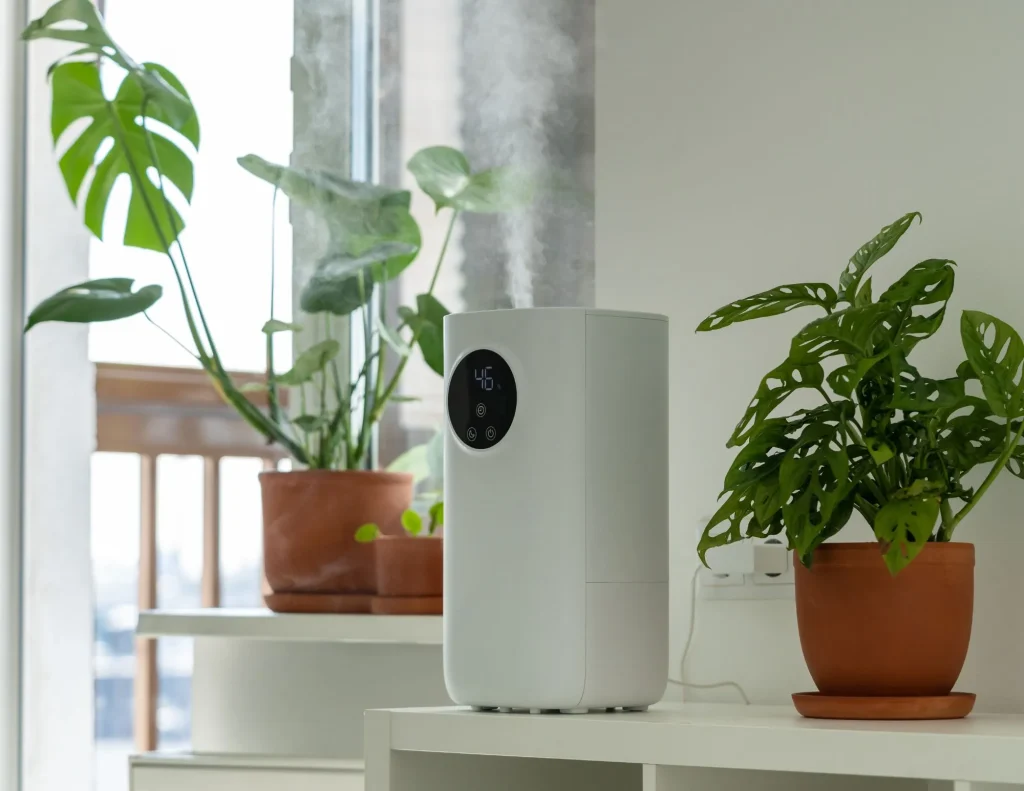
Low Humidity
- What Happens: Dry air pulls moisture from leaves, causing them to yellow and curl.
- Signs:
- Yellowing, curling leaves on tropical plants like ferns or calatheas.
- Brown tips or edges.
- Solution:
- Increase humidity with a humidifier or pebble tray.
- Group plants together to create a micro-humid environment.
High Humidity
- What Happens: Excessive humidity can lead to fungal issues or over-saturation of soil, causing yellowing.
- Signs:
- Yellowing leaves with spots or mold on the soil surface.
- Solution:
- Improve airflow with a fan or by spacing plants apart.
- Reduce watering to prevent oversaturation.
6. Pest Infestations
Pests can cause physical damage to leaves, disrupting nutrient and water absorption.
Common Pests That Cause Yellowing
- Spider Mites: Cause tiny yellow spots and fine webbing.
- Aphids: Leave a sticky residue and deform leaves.
- Scale Insects: Appear as brown bumps on stems and leaves.
- Thrips: Cause streaking and yellowing on leaves.
Solution:
- Inspect plants regularly for signs of pests.
- Treat infestations with:
- Neem Oil: Spray leaves thoroughly to suffocate pests.
- Insecticidal Soap: Use for soft-bodied pests like aphids.
- Rubbing Alcohol: Dab directly on scale insects or mealybugs.
- Isolate affected plants to prevent the spread of pests.
7. Root Issues
Healthy roots are the foundation of thriving plants, and problems below the soil often manifest as yellowing leaves.
Root Bound Plants
- What Happens: When roots outgrow their pot, they become crowded and unable to absorb enough water and nutrients.
- Signs:
- Yellowing leaves accompanied by slow or stunted growth.
- Roots circling the bottom of the pot or emerging from drainage holes.
- Solution:
- Check the roots by gently removing the plant from its pot.
- Repot into a slightly larger container with fresh, nutrient-rich soil.
Poor Soil Quality
- What Happens: Over time, soil loses its nutrients and structure, affecting water retention and aeration.
- Signs:
- Yellow leaves and compacted, hardened soil.
- Solution:
- Refresh the soil by repotting and replacing it with a high-quality potting mix suited to the plant type.
8. Natural Aging
Yellowing leaves can sometimes be a natural process as plants shed old foliage to make way for new growth.
- What Happens: Older leaves at the bottom of the plant turn yellow and eventually fall off.
- Signs:
- Only lower leaves are yellowing, while new growth remains healthy.
- Solution:
- Prune yellowing leaves to improve the plant’s appearance.
- No additional action is necessary if the plant is otherwise healthy.
Diagnosing Yellowing Leaves: A Step-by-Step Guide
To identify the cause of yellowing leaves, follow these steps:
- Check the Soil
- Is it too wet, dry, or compacted? Adjust your watering routine accordingly.
- Assess Lighting
- Is the plant receiving too much or too little light? Relocate to a more suitable spot or use grow lights.
- Inspect for Pests
- Look under leaves and along stems for pests or damage. Treat infestations promptly.
- Evaluate Temperature and Humidity
- Note the environment around your plant. Adjust placement or use tools like humidifiers to maintain ideal conditions.
- Review Nutrient Levels
- Have you fertilized recently? Consider adding a balanced fertilizer if deficiencies are suspected.
- Check the Roots
- Look for signs of root binding or rot. Repot if necessary.
Preventing Yellowing Leaves
- Maintain a Consistent Watering Routine: Learn your plant’s watering needs and adjust for seasonal changes.
- Optimize Light Levels: Research each plant’s light requirements and position them accordingly.
- Feed Regularly: Use the right fertilizer during the growing season and monitor for deficiencies.
- Monitor the Environment: Keep plants away from drafts, maintain stable temperatures, and ensure proper humidity.
- Inspect Weekly: Regularly check for pests, soil conditions, and overall plant health.
Final Thoughts
Yellowing leaves on houseplants may seem worrisome, but they’re often a signal that something in your plant’s care routine needs adjustment. By understanding the possible causes—whether it’s watering, lighting, nutrients, or pests—you can take the necessary steps to restore your plant’s health and prevent future issues.
Your Next Step: Take a close look at your houseplants today. Use the tips in this guide to diagnose and address any yellowing leaves, and watch as your plants return to their lush, vibrant selves!
Have a specific issue or success story? Share it in the comments below—we’d love to hear from you!

